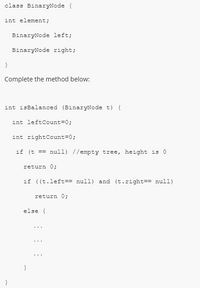
Computer Networking: A Top-Down Approach (7th Edition)
7th Edition
ISBN: 9780133594140
Author: James Kurose, Keith Ross
Publisher: PEARSON
expand_more
expand_more
format_list_bulleted
Question
thumb_up100%
Complete the pseudo-code method isBalanced which determines if a binary tree is balanced. The function returns a value of -1 if the tree is not balanced, otherwise it returns the height of the tree. Add comments to explain what your code segment is doing.

Transcribed Image Text:class BinaryNode {
int element;
BinaryNode left;
BinaryNode right;
Complete the method below:
int isBalanced (BinaryNode t) {
int leftCount=0;
int rightCount=0;
if (t == nul1) //empty tree, height is O
return 0;
if ((t.left== null) and (t.right== null)
return O;
else {
}
}
Expert Solution
This question has been solved!
Explore an expertly crafted, step-by-step solution for a thorough understanding of key concepts.
This is a popular solution
Trending nowThis is a popular solution!
Step by stepSolved in 2 steps with 2 images

Knowledge Booster
Similar questions
- Practice / Frequency of Characters Write a method that returns the frequency of each characters of a given String parameter. If the given String is null, then return null If the given String is empty return an empty map Example input: output: empty map explanation: input is empty Example input: null output: null explanation: input is null. Since problem output is focused on the frequency we can comfortably use Map data structure. Because we can use characters as key and the occurrences of them as value. Example input: responsible output: {r=1, e=2, s=2, p=1, o=1, n=1, i=1, b=1, l=1} explanation: characters are keys and oc values ences arearrow_forwardMatich the following statements with the correct data structure by clicking on the drop down arrow and selecting the correct choice.. You need to store a list of elements and the number of elements in the program is fixed. If most of operations on a list involve retrieving an element at a given index. You have to add or delete the elements at the beginning of a list. Linked List ArrayList Arrayarrow_forwardUsing jGRASP please de-bug this /**This program demonstrates an array of String objects.It should print out the days and the number of hours spent at work each day.It should print out the day of the week with the most hours workedIt should print out the average number of hours worked each dayThis is what should display when the program runs as it shouldSunday has 12 hours worked.Monday has 9 hours worked.Tuesday has 8 hours worked.Wednesday has 13 hours worked.Thursday has 6 hours worked.Friday has 4 hours worked.Saturday has 0 hours worked.Highest Day is Wednesday with 13 hours workedAverage hours worked in the week is 7.43 hours*/{public class WorkDays{public static void main(String[] args){String[] days = { "Sunday", "Monday", "Tuesday","Wednesday", "Thursday", "Friday", "Saturday"}; int[] hours = { 12, 9, 8, 13, 6, 4}; int average = 0.0;int highest = 0;String highestDay = " ";int sum = 0; for (int index = 0; index < days.length; index++){System.out.println(days[index] + " has "…arrow_forward
- Java - Normalizingarrow_forwardWrist a code to find the iterative sum of an array and the range (max and min)arrow_forward] ] get_nhbr In the cell below, you are to write a function called "get_nhbr(Ist, graph)" that takes in two inputs: a list of vertices and a graph. The function is to return a list that contains the neighborhood of the vertices in 'Ist' (remember that this means you are finding the union of the individual vertices' neighborhoods). + Code + Markdown After compiling the above cell, you should be able to compile the following cell and obtain the desired outputs. print (get_nhbr(["A", "D"], {"A" : ["B"], "B" : ["A", "D", "E"], "C" : ["E"], "D":["B"], "E":["B","C","F"], "F":["E"]}), get_nhbr(["B", "C", "F"], {"A" : ["B"], "B" : ["A", "D", "E"], "C" : ["E"], "D":["B"], "E":["B","C","F"], "F":["E"]})) This should return ["B"] ["A", "D", "E"] Python Pythonarrow_forward
arrow_back_ios
arrow_forward_ios
Recommended textbooks for you
 Computer Networking: A Top-Down Approach (7th Edi...Computer EngineeringISBN:9780133594140Author:James Kurose, Keith RossPublisher:PEARSON
Computer Networking: A Top-Down Approach (7th Edi...Computer EngineeringISBN:9780133594140Author:James Kurose, Keith RossPublisher:PEARSON Computer Organization and Design MIPS Edition, Fi...Computer EngineeringISBN:9780124077263Author:David A. Patterson, John L. HennessyPublisher:Elsevier Science
Computer Organization and Design MIPS Edition, Fi...Computer EngineeringISBN:9780124077263Author:David A. Patterson, John L. HennessyPublisher:Elsevier Science Network+ Guide to Networks (MindTap Course List)Computer EngineeringISBN:9781337569330Author:Jill West, Tamara Dean, Jean AndrewsPublisher:Cengage Learning
Network+ Guide to Networks (MindTap Course List)Computer EngineeringISBN:9781337569330Author:Jill West, Tamara Dean, Jean AndrewsPublisher:Cengage Learning Concepts of Database ManagementComputer EngineeringISBN:9781337093422Author:Joy L. Starks, Philip J. Pratt, Mary Z. LastPublisher:Cengage Learning
Concepts of Database ManagementComputer EngineeringISBN:9781337093422Author:Joy L. Starks, Philip J. Pratt, Mary Z. LastPublisher:Cengage Learning Prelude to ProgrammingComputer EngineeringISBN:9780133750423Author:VENIT, StewartPublisher:Pearson Education
Prelude to ProgrammingComputer EngineeringISBN:9780133750423Author:VENIT, StewartPublisher:Pearson Education Sc Business Data Communications and Networking, T...Computer EngineeringISBN:9781119368830Author:FITZGERALDPublisher:WILEY
Sc Business Data Communications and Networking, T...Computer EngineeringISBN:9781119368830Author:FITZGERALDPublisher:WILEY

Computer Networking: A Top-Down Approach (7th Edi...
Computer Engineering
ISBN:9780133594140
Author:James Kurose, Keith Ross
Publisher:PEARSON

Computer Organization and Design MIPS Edition, Fi...
Computer Engineering
ISBN:9780124077263
Author:David A. Patterson, John L. Hennessy
Publisher:Elsevier Science

Network+ Guide to Networks (MindTap Course List)
Computer Engineering
ISBN:9781337569330
Author:Jill West, Tamara Dean, Jean Andrews
Publisher:Cengage Learning

Concepts of Database Management
Computer Engineering
ISBN:9781337093422
Author:Joy L. Starks, Philip J. Pratt, Mary Z. Last
Publisher:Cengage Learning

Prelude to Programming
Computer Engineering
ISBN:9780133750423
Author:VENIT, Stewart
Publisher:Pearson Education

Sc Business Data Communications and Networking, T...
Computer Engineering
ISBN:9781119368830
Author:FITZGERALD
Publisher:WILEY